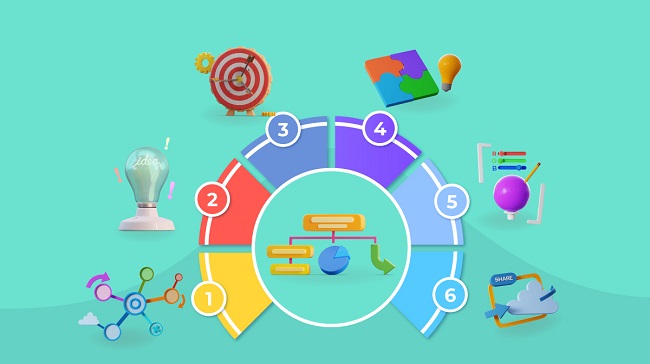Visualizing relationships between concepts through the use of a mind map is an innovative approach to the brainstorming process. If you do it well, brainstorming can help you solve difficult problems, plan an article or presentation, and organize your thoughts.
When I need to organize my thoughts visually, I almost always turn to a digital mind map. When I do use paper, I usually replicate the map in digital form so that it can be readily archived and found later. (It’s an odd mix, but it seems to work for me.)
While keeping this list up-to-date over the past few years, I’ve tried out close to 50 unique mind map programs, some of which I’ve tried multiple times thanks to frequent feature updates.

I’ve also created a large number of mind maps by hand and on the computer. Even though pen and paper established a high standard, these five apps for mind mapping are able to meet or exceed it.
The 5 Best Mind Mapping Tools in 2023
Here is a list of top 5 mind mapping tools in 2023:
1. Coggle
Coggle is superior to other mind mapping tools in many respects. Although it can only be accessed via a web browser, it is quick, straightforward, and user-friendly (with excellent keyboard shortcuts).
The best part is that you can use Coggle without paying anything for up to three personal mind maps. You can have infinite free mind mapping as long as you save your mind maps as PDFs, plain text documents, or photos and then discard any previous versions you may have created.
It’s almost ideal if you only want to use a digital choice once every few months. When you first use Coggle, you’ll be presented with the hub node of a brand new mind map. When you get there, you can add new nodes by clicking the plus symbol or, for a quicker navigation experience, by touching the tab key.
It is highly recommended that you familiarize yourself with the app’s keyboard shortcuts, which are listed in a helpful cheatsheet located in the app’s lower-right corner.
2. MindMeister
When it comes to group mind mapping applications, MindMeister ranks well. It’s not quite as user-friendly as Coggle, and it requires a premium plan if you want access to features like exporting your mind maps as a PDF or image, or attaching images and videos.
Its strength, however, is in the ease with which teams can work together on a single project through the use of its collaborative features.
As an added bonus, it sports a clean, up-to-date user interface and a wide range of configuration settings (including some more corporate layouts). It also automatically aligns your nodes, making it simple to design professional-looking mind maps for use in presentations.
3. Lucidspark
Sticky notes, free-form painting, comments, tasks, automatic sorting, Breakout Boards, a laser pointer, a timer, and voting are just a few of the real-time collaboration and facilitation tools offered by Lucidspark.
Users can get started with a blank canvas and customize it with sticky notes and other shapes, or they can choose from pre-made templates for common situations like brainstorming, mind mapping, meetings and workshops, strategic analysis, project planning, and Agile development.
Quickly share content with team members by embedding PDFs, PNGs, and other files onto the canvas and then creating presentations or frame-by-frame routes. It won’t take you long to get the hang of Lucidspark’s intuitive and flexible user interface. All functions are easily accessible via the toolbars, and new users may also view a quick lesson and learn all the shortcut keys.
4. Miro
Mind maps, Kanban boards, Gantt charts, product wireframes, research boards, and flowcharts are just some of the more than 1,000 designs available in Miro, a collaborative online whiteboard.
Companies like TransUnion, HP, Upwork, Cisco, Qlik, and Atkins all utilize it on a regular basis, and it is trusted by 99.9% of the Fortune 100. The Miro visual platform is designed for remote and office-based collaboration and features extensive learning tools like an online academy, regular events, and a lively online community.
Check out Mind Map, one of Miro’s most recommended layouts. It’s a simple, quick, and effective method for groups to record, sort, and structure their thoughts.
The collaborative brainstorming, planning, mapping of information architecture, creating of org charts, and strategy development made possible by mind mapping is a boon to in-person, remote, and hybrid teams.
In addition, Miro makes it easy to collaborate with its built-in chat, comments, and automated content organization and addition features.
5. Invision
Mind mapping, note taking, and wireframing are just some of the collaborative activities that can be carried out with InVision Freehand, an online whiteboard that is available for free.
Teams at Fortune 500 businesses utilize it, including Microsoft, Amazon, American Express, and KPMG. Everyone from PMs and Marketers to Recruiters and Engineers will feel right at home with Freehand because to its user-friendliness.
Freehand lets you spend more time really contributing during brainstorming, planning, and guiding meetings, rather than trying to figure out how to contribute.
Conclusion
Conventionally, a mind map is drawn on paper using a pen (or, ideally, many different colored pens). To begin, you take a blank sheet of paper and write down the one thing that you want to focus on.
Then comes the exciting part: developing a web of “nodes” connected by lines, each one representing a different thought or theme that orbits your center theme.
In a marketing campaign where the overarching theme is “Summer,” some of the first nodes could be “Good weather,” “BBQs,” “Vacation,” “Air Conditioning,” and “School’s out.”
















